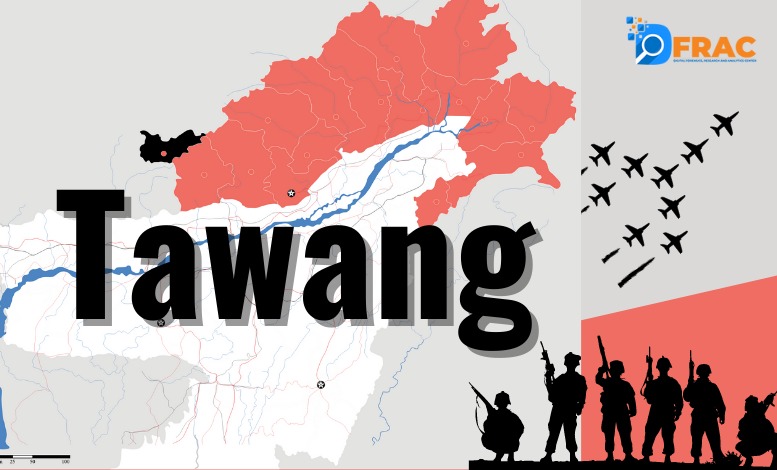Refreshing the memory of the Galvan incident in Ladakh two years ago, on the 9th of this month, there was a serious confrontation between the soldiers of India and China at the remotest Yangtse border post in the Tawang sector of Arunachal Pradesh. The recent scuffle between Indian troops and a group of around 300 Chinese soldiers attempting to enter the Indian-controlled Tawang area has been described as the most serious face-off between the Indian and Chinese forces since the 2020 Galvan incident. After pushing back the Chinese troops, the Indian Army said in a brief statement that five Indian soldiers were injured in the encounter and the situation is under control.
Even though this time the violence of the military skirmish was limited to a great extent, after the Galvan incident that brought India-China relations to the abyss, again such action from China is indicating that the intentions of Chinese President Xi Jinping aren’t diplomatic or friendly.
Such apprehension is growing because the Chinese President and his communist government are scared of the wave of public anger rising in China due to the abysmal failure regarding Covid. In such a situation, it seems that Xi, who holds all the positions as Chinese President including the Communist Party chief and Commander-in-Chief of the People’s Liberation Army (PLA), is resorting to such activities only to divert the attention of its people. There is no dearth of those who believe that Xi can create a situation of war with India or Taiwan anytime to cool down public anger against him in his own country led by the anti-COVID crackdown protests. In such a situation, the question becomes important: With which of the two countries does Xi consider it more beneficial to compete?
Some experts on Chinese affairs believe that by attacking Taiwan, China could become embroiled in an international conflict in which Xi’s dream of complete control of Taiwan would not be fulfilled. China also understood about India that instead of 1962, today’s India can retaliate, which will cost China very dearly. After this, his dream of world conquest may collapse. Whatever the case, Xi Jinping can go to any extent into a state of debauchery and the Tawang episode is the latest example of this, which has given a signal to India to be alert.
This is not the first time that Chinese troops have tried to change the Line of Control in Arunachal’s Yangtze region, but this time the number of Chinese troops trying to enter Indian territory was more than three hundred, while usually, 20-25 Chinese troops have been coming to patrol this area only. There is a mutual understanding between the armies of India and China that while patrolling, no soldier of either side will carry a gun, pistol, or any such deadly weapon. For this reason, the conflicts that occur in such a situation are limited to shouting, sloganeering, and pushing each other. Perhaps this is the reason why the confrontation in Tawang also did not go beyond pushing and shoving.
At the same time, in June 2020, Chinese soldiers in Galvan, instead of following the rule of remaining unarmed, suddenly attacked Indian soldiers with deadly weapons like iron rods with welded nails and poles equipped with barbed wire. In that attack, 20 soldiers including the Indian commander were killed, but the timely arrival of the new Kumuk of the Indian Army turned the tide. The Chinese government kept silent on its casualties in Galvan for a whole year and later accepted the death of only four soldiers. However, intelligence agencies operating in China from some countries, including the US, later claimed that 42 Chinese soldiers were killed in the encounter. This claim was also confirmed by satellite images.
The clash in Tawang proved that the preparedness of the Indian Army in this area is very strong and soldiers are fully prepared to deal with such a situation. Earlier there have been reports that China has not only developed a year-round network of roads along its nearly 3,500 km long border with India but on the personal initiative of President Xi, In many areas of the border, more than 600 such new villages have been established, in which everything from pucca houses to roads, electricity, schools, and broadband internet facilities are also available. China’s intention behind this is not only to strengthen its military power in the region but also to permanently settle civilians there to strengthen its claim on the region. President Xi’s personal interest in setting up border villages can be understood from the fact that during a surprise visit to Tibet in August last year, he also visited the border with Arunachal Pradesh and visited one such village, but The real purpose of his visit to the border was to take stock of his military preparations.
China’s new aggressive act in the Tawang area is also very serious in the sense that the Government of India has made it clear to China as well as to the world that unless China reduces the tension on the Indian border and withdraws its forces to the earlier places Till then there would be no talk of co-operation with him in other matters. China is worried that India is sticking to its policy. His actions in Tawang could also be his grumpy reaction. The implicit message for New Delhi is also clear in this that India should be prepared for war with China as well.




